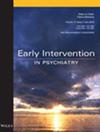An Exploration of the Co-Occurrence of Hallucinations and Suicidal Mental Imagery Among Psychiatrically Hospitalised Adolescents at High Risk for Suicide
Abstract
Introduction
Adolescents with psychosis-spectrum symptoms are at particularly high risk for suicide, however, little is known about how suicidal cognitions manifest in this population. Suicidal cognitions can occur as verbal thoughts and/or mental images of suicide, and mental images may be indicative of a higher risk for suicidal behaviours. Suicidal mental imagery could be a salient and important suicide-related risk factor for adolescents with hallucinations in particular, however, the co-occurrence of these phenomena has yet to be studied. In a sample of psychiatrically hospitalised adolescents, we hypothesize that hallucinations will be associated with increased suicidal mental imagery and suicide attempts.
Methods
This chart review study included data from 219 adolescents admitted to a psychiatric inpatient unit. Adolescents completed an assessment battery probing hallucinations, suicidal cognitions, and suicide attempts.
Results
Adolescents with past-month hallucinations had higher rates of past-week suicidal verbal thoughts and suicidal mental imagery, but not suicide attempts, compared to those without hallucinations. Adolescents with hallucinations reported a younger onset of suicidal mental imagery, and they endorsed more frequent imagery. Past-month hallucinations were significantly and positively associated with suicidal mental imagery, beyond the effects of internalising symptoms. Suicidal mental imagery was positively associated with past-week suicide attempts, but past-month hallucinations were not.
Conclusions
Our findings indicate that hallucinations are linked to suicidal mental imagery, an important yet under-studied risk factor for suicidal behaviour. These data highlight the need for more research exploring suicidal mental imagery among high-risk adolescents experiencing hallucinations to inform suicide risk assessment and intervention.

 求助内容:
求助内容: 应助结果提醒方式:
应助结果提醒方式:


